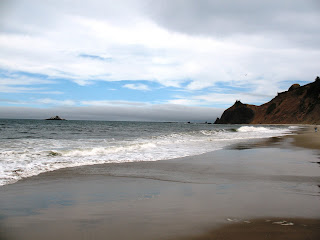 |
| My dog, Harmony provided a warm welcome upon my return |
With the
rocky coasts and ocean breezes of the West Coast still fresh in my mind, I’ve
returned to Columbia, SC and am settling back into my home. As suspected, I do
miss the places and people that I met this summer and yet have many fond
memories (and pictures galore…) to keep random smiles across my face. All in
all, I traveled over 3,000 miles, met with nearly eighty people that
collectively survey over 70 beaches and have approximately 150 hours of
interview recordings to transcribe!!! I’d say that was a successful trip!
Beginning
a new semester, my attention has started to turn towards dissertation analysis.
At a basic level, my summer research project with COASST participants was
focused on how citizen science participants make meaning of volunteer
experiences. In particular, I spent a good bit of time talking with folks about
motivation to engage in citizen science, the value of participation, and
connection to place and nature. What I found along the way was a wide array of
responses to the questions I asked along these lines, revealing a diverse
landscape of motivations to engage, relationships with place, and personal
outcomes of the program. And I think that is just fantastic because, while it
is perhaps not all that surprising, it is quite encouraging nonetheless.
Encouraging because there are a whole host of folks across multiple states and
communities who want to make a difference, for a huge variety of reasons, and who
find citizen science to be a particularly fitting avenue through which to make
a significant contribution. As a birder and appreciator of wildlife, that is
welcome news.
As a nature-society geographer, it is equally intriguing. Like I shared with many of those I met with this summer, citizen science, I believe, provides a unique avenue to explore the world around us, to see things in a new light, from a different perspective, and to connect in possibly a nuanced way with those places right under our noses. That’s why for the next several months, I’ll be diligently reviewing and analyzing the information I collected this summer to think more directly about why folks participate in citizen science projects like COASST, what they get out of it, how the experiences impact them on a personal level, and what aspects of the COASST program are most valued by participants.

I’ll also consider more theoretical questions like how individuals connect to and perceive the environment; develop perceptions, values, and attitudes about human-environment interactions; and make meaning of experiences with nature. This kind of analysis and the writing that will follow will, no doubt, take many months. It is likely to be at least a year before I near completion of my writing and am able to share any substantial results. Once my writing is complete, the participants in my study will be among the first to see the final product. My dissertation committee, of course, will then have to give the final thumbs up!
Until then, I welcome additional thoughts, ideas, or insights from those that participated in the study. Feel free to email me (if you don't have my email already, please leave a comment here) or connect with me on LinkedIn.
Finally,
I want to quickly express my sincere thanks to the great team of staff members at the University of Washington COASST office, The Office of the Vice President for Research at the University of South Carolina, and my home department of
Geography. And none of this would have been possible without the kind and
welcoming array of COASSTers I met with along the way. You all have touched me
in numerous ways and will serve as a source of motivation as I continue my
research journey.
Until we
meet again, Ben
















































